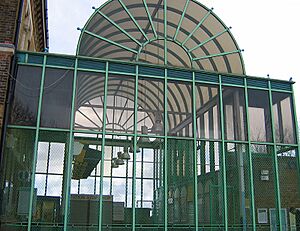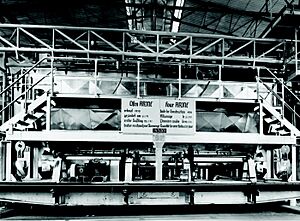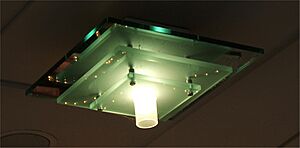Float glass facts for kids

Float glass is a special type of glass that is made by floating melted glass on top of a bed of hot, liquid metal. This metal is usually tin, but in the past, lead was also used. This cool method helps the glass become super flat and have the same thickness all over.
This way of making glass is also called the Pilkington process. It's named after a British company called Pilkington. They were the first to figure out how to do this in the 1950s at their factory in St Helens, Merseyside.
Most modern windows are made from float glass. However, some companies, like Corning Incorporated, use a different method called the overflow downdraw method.
Most float glass is a common type called soda–lime glass. But sometimes, smaller amounts of special glass, like borosilicate glass (used in ovenware) or glass for flat panel displays, are also made using the float process.
Contents
How Float Glass Was Invented
For a long time, before the 16th century, window glass was often cut from big round pieces of glass called crown glass. To make bigger sheets, people would blow huge glass cylinders. These cylinders were then cut open and flattened out.
In the early 1800s, most window glass was made using this "cylinder method." The glass cylinders were about 6 to 8 feet (180 to 240 cm) long and 10 to 14 inches (25 to 36 cm) wide. This limited how wide a window pane could be. That's why old windows often have many small glass sections.
A big step forward happened in 1848 when Henry Bessemer got patents for new ways to make glass. His idea was to make a continuous ribbon of flat glass using rollers. But this was expensive because the glass surfaces still needed to be polished.
People then started thinking: what if the hot, liquid glass could sit on a perfectly smooth, flat surface, like a calm pool of liquid? This would make glass much cheaper! They tried using molten tin because it's heavier than glass and stays calm even when very hot. Many patents were given, but the process didn't work well at first.
Before float glass, large sheets of "plate glass" were made by pouring hot glass onto an iron surface. Then, both sides had to be polished, which cost a lot of money. In the 1920s, a new way came along: a continuous ribbon of plate glass went through many grinders and polishers. This helped reduce waste and cost.
There was also "drawn glass," which was lower quality. It was made by pulling a thin sheet of glass upwards from a pool of melted glass. Rollers held the edges. As it cooled, it became stiff and could be cut. But its surfaces weren't as smooth as float glass.
The real breakthrough came between 1953 and 1957. Sir Alastair Pilkington and Kenneth Bickerstaff from Pilkington Brothers in the UK finally created a successful way to make a continuous ribbon of glass. They used a bath of molten tin where the hot glass flowed freely, flattened by its own weight.
This method worked because they carefully controlled how much glass went onto the tin bath. By 1960, float glass was being sold widely and making a profit. In the 1960s, other companies around the world started using this process, and it replaced older ways of making glass.
How Float Glass Is Made
Float glass is made from common glass ingredients. These include sand, soda ash (sodium carbonate), dolomite, limestone, and salt cake (sodium sulfate). Other materials can be added to give the glass color, make it clearer, or change its properties.
All these raw materials are mixed together. Then, they are fed into a large furnace along with some cullet (which is recycled waste glass). The furnace heats everything up to about 1500°C (2732°F).
Big float glass furnaces can be 9 meters (30 feet) wide and 45 meters (148 feet) long. They can make over 1200 tons of glass! Once the glass is melted, its temperature is lowered to about 1200°C (2192°F). This makes sure the glass is smooth and even.
The melted glass then flows into a "tin bath." This is a pool of molten tin about 3-4 meters (10-13 feet) wide, 50 meters (164 feet) long, and 6 centimeters (2.4 inches) deep. The glass pours onto the tin from a ceramic "spout lip." A special gate called a tweel controls how much glass flows out.
Molten tin is perfect for this process because it's heavier than glass, so the glass floats on top. Also, tin's boiling point is much higher than glass's melting point. This means the tin won't boil away during the process.
However, tin can react with air to form tin dioxide, which is called "dross." This dross can stick to the glass. To stop this, the tin bath is filled with a protective atmosphere of nitrogen and hydrogen gases. This keeps oxygen away from the tin.
As the glass flows along the tin surface, it forms a flat ribbon with perfectly smooth surfaces on both sides. The temperature slowly drops from 1100°C (2012°F). When it reaches about 600°C (1112°F), the glass sheet is solid enough to be lifted off the tin onto rollers.
These rollers pull the glass ribbon off the bath at a controlled speed. By changing how fast the glass flows and how fast the rollers pull, they can make glass sheets of different thicknesses. Special rollers above the molten tin can also help control the glass's thickness and width.
After leaving the tin bath, the glass sheet goes through a long lehr kiln, which is about 100 meters (328 feet) long. Here, the glass cools down very slowly. This process, called annealing, prevents the glass from cracking due to sudden temperature changes. When the glass comes out of the "cold end" of the kiln, machines cut it into desired sizes.
What Float Glass Is Used For
Today, float glass is the most common type of glass made. It has many uses in businesses and homes. Because it's high quality and doesn't need extra polishing, and because it can be shaped easily when hot, it's perfect for many things.
Here are some common uses:
- Car glass: Like windshields, windows, and mirrors in cars.
- Mirrors: The smooth surface is great for making clear mirrors.
- Furniture: Used in tables, shelves, and display cases.
- Insulated glass: Used in double-pane windows to help keep buildings warm or cool.
- Windows and doors: The most common use for homes and buildings.
Many special types of glass start as float glass and are then processed further. These include toughened glass (which is stronger), frosted glass, laminated safety glass (which doesn't shatter into sharp pieces), and soundproof glass.
Who Makes Float Glass
As of 2009, four main companies lead the world market for float glass (not counting China and Russia). These are Asahi Glass, NSG/Pilkington, Saint-Gobain, and Guardian Industries. Other important companies include Sise Cam AS, Vitro, Central Glass, Hankuk (HanGlas), Carlex Glass, and Cardinal Glass Industries.
See also
- Soda–lime glass, which is what most float glass is made of.
- Glass production
- Glass batch calculation




